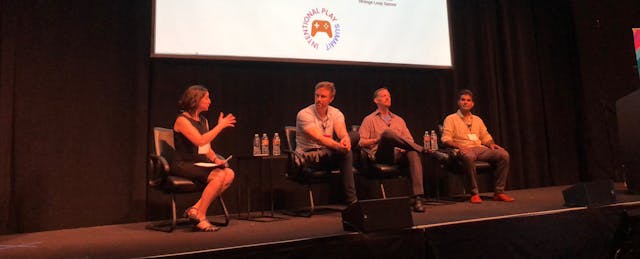Playing games in the classroom is not a new concept. So, it’s perhaps not surprising that there are game-based edtech companies hoping to leave a mark in classrooms. But what goes into building a game-based learning startup—or any edtech startup? At the Intentional Play Summit, a conference focused on the intersection of gaming and education in Mountain View, Calif., three entrepreneurs described what it takes to become successful in that space.
Finding a (Sustainable) Business Model
Grant Hosford, the co-founder and CEO of codeSpark, an app that teaches kids, ages 5- to 10- years old how to code, advised the audience that you can make some choices for your company that appear good at first and even midway through. But all of the sudden, you might find that your company, and the world, is changing—and as a result, you might have to question, or change, those initial decisions.
Take codeSpark. Hosford said schools can get the app for free, but parents who wish to use it at home must pay for a subscription. The idea behind this model was the app would be broadly distributed, reaching “as many kids as possible,” including underserved kids, while still building a sustainable business.
While that model is working in the U.S., Hosford noted that codeSpark has grown internationally. Going freemium isn’t necessarily the right one for those markets—most notably China, which “doesn’t love subscriptions,” Hosford observed. That’s left the company “scrambling to figure out” how to approach selling its product outside the U.S.
John Krajewski, the founder and CEO of Strange Loop Games, said game-based startups should find a way to test assumptions about their products early in order to avoid having a long period of risk where they’re unsure if their idea will work. His company explored assumptions early through Kickstarter and having early access on gaming platform, Steam, as well as its own website.
“It’s like a bridge to a bridge to a bridge,” Krajewski said. “At each point, we’re revising the product, we’re taking customer feedback and adding it to what we’re building.”
Know Your Customers
Pramod Sharma, the co-founder and CEO of Osmo, doesn’t think it’s wise to build a product in isolation and assume kids will like it. He recalled spending three months working with his cofounder on a product before trying it out on a kid. “It was a disaster,” he said.
Hosford said that entrepreneurs should be mindful of who they test their products on, because what works for one group won’t necessarily work for another. The first place outside the office that Hosford and his co-founder tested their product in was at an elementary school where the majority of students were eligible for free lunch.
“We had some eye opening moments, where things that we thought were clear for one reason or another just weren’t,” Hosford explained, adding that “roughly 50 percent of the kids had never touched a computing device of any kind before, except maybe a parent’s cell phone.”
Entrepreneurs also have to consider teachers, Hosford said, telling the audience that even if a product is free, they expect “a fair amount of support.” Once a company gets past early adopter teachers, it will encounter teachers who expect more support, including professional development. “We’ve ended up building out more of a support infrastructure than we originally anticipated.”
But on the bright side, Hosford noted that once teachers find a product they like, they share it. Hosford estimates that almost 40 percent of the families paying for codeSpark heard of it through a school encounter—either because their student used it or because a teacher shared that the class was using it.
“We believe we have to win the child’s attention to have the right to teach them,” Hosford said, adding that it’s imperative for his company to deliver meaningful educational outcomes, and provide proof of those outcomes.
However, Hosford believes companies should draw lines about certain aspects of their business, and stick to them. He said codeSpark doesn’t approach teaching coding by dividing up courses based on grade level (for instance, labeling a course as being “for kindergarteners” or “ for first graders”). He said what he's done isn't something the school market necessarily wants.
Funding Avenues
Hosford and Sharma had funding from sought venture capitalists. Sharma believes grit and persistence are key to getting venture capital money. He also thinks decisions in the venture capital funding process are emotional, not logical ones, and it’s important for entrepreneurs to get venture capitalists excited about what they’re doing.
But venture capital is not the only path to funding. Hosford pointed out that there are some non-profit funds out there, as well as accelerator programs. His company got some money from nonprofit venture philanthropy organization NewSchools Venture Fund, and also went through a now-defunct accelerator called co.lab. And entrepreneurs can also crowdfund, which Krajewski did with Kickstarter.
There are government grants, too. Hosford’s company recently won its first Small Business Innovation Research (SBIR) grant from the Department of Education. Krajewski has gotten some government funding, too—three SBIRs from the Department of Education and one from the National Science Foundation. The process, Krajewski says, requires a lot of documentation, and it takes several months to hear back.
“It does make it kind of challenging on the structure of the company,” Krajewski said. “If you’re fully reliant on [government grants], you’re going to have to be doing something else while you’re waiting for it. But once you do get that funding, if you have checked all the boxes and they like what you’ve proposed, then they’re very hands off until the next phase.”
Krajewski isn’t ruling out venture capital funding in the future, but he does think that the “funding you take kind of determines the character of your organization a lot”—for example, a venture capitalist will want to see rapid growth.


